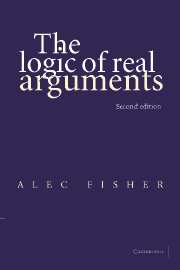Book contents
- Frontmatter
- Contents
- Preface to the first edition
- Preface to the second edition
- Acknowledgements
- 1 Introduction
- 2 A general method of argument analysis
- 3 A first example – from Thomas Malthus
- 4 Reasoning about nuclear deterrence
- 5 An example from John Stuart Mill
- 6 Arguments about God's existence
- 7 How do your mind and body interact?
- 8 Suppose for the sake of argument that …
- 9 An example from Karl Marx
- 10 Evaluating ‘scientific’ arguments. Some initial examples
- 11 Philosophical assumptions
- Appendix: Elementary formal logic
- Exercises
- Bibliography
- List of further reading
- Index
2 - A general method of argument analysis
Published online by Cambridge University Press: 05 June 2012
- Frontmatter
- Contents
- Preface to the first edition
- Preface to the second edition
- Acknowledgements
- 1 Introduction
- 2 A general method of argument analysis
- 3 A first example – from Thomas Malthus
- 4 Reasoning about nuclear deterrence
- 5 An example from John Stuart Mill
- 6 Arguments about God's existence
- 7 How do your mind and body interact?
- 8 Suppose for the sake of argument that …
- 9 An example from Karl Marx
- 10 Evaluating ‘scientific’ arguments. Some initial examples
- 11 Philosophical assumptions
- Appendix: Elementary formal logic
- Exercises
- Bibliography
- List of further reading
- Index
Summary
In Chapter 1 we considered several examples; most of them were arguing a case and we used them to point up various lessons about reasoning. Having given the reader a taste of argument analysis we now introduce a general method for analysing and evaluating arguments. The method lay behind what was said in Chapter 1 but the reader who tried the exercises should now be ready for a general account rather than the piecemeal approach.
The method which we describe applies to reasoning, or argument, as it actually occurs in natural language – in our case, English. We begin by describing how to recognise contexts in which reasoning is taking place (i.e. we say what the ‘linguistic clues’ are). We then describe how to uncover and display the structure of a piece of reasoning (whether it is a ‘chain’ of reasons etc.). Finally we explain, as far as possible, how to decide whether the reasoning is correct or incorrect.
At this stage we do no more than outline the method. We do this so that its essential lines may be boldly drawn and clearly grasped. Too many qualifications at this point might obscure the method's basic simplicity: if it is basically correct the place to develop and refine it is where the problems arise – in applying it to particular examples – and this is what we shall do. In subsequent chapters the basic skeleton will be extended and ‘fleshed out’ as the need arises.
- Type
- Chapter
- Information
- The Logic of Real Arguments , pp. 15 - 28Publisher: Cambridge University PressPrint publication year: 2004



